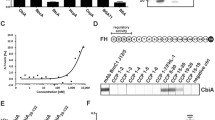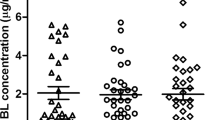Summary
The complement regulator-acquiring surface protein (CRASP)-1 is a member of the paralogous gene family gbb54 and the dominant FHL-1 and factor H binding protein of Borrelia burgdorferi sensu stricto (s.s.). It was shown recently that expression of BbCRASP-1 directly correlates with serum resistance of B. burgdorferi s.s. isolates. In the present study we have elucidated the putative potential of other members of the gbb54 paralogous family, including orthologs ZSA66, ZSA69, ZSA70, ZSA71, ZSA72 and ZSA73 of the European B. burgdorferi s.s. strain ZS7, to bind human FHL-1 and factor H. In spite of their overall similarity in protein sequence, between 47% and 67%, and the fact that the C-terminal region of ZSA69 shows 70% similarity with BbCRASP-1, none of the orthologous proteins was able to bind human FHL-1 and/or factor H. BbCRASP-1 is the only member of the paralogous gene family gbb54 that binds to human complement regulators, supporting the notion that BbCRASP-1 plays a critical role in evasion of complement by B. burgdorferi s.s. and thus may be helpful in the development of novel therapeutic strategies against Lyme borreliosis.
Similar content being viewed by others
References
Steere AC, Coburn J, Glickstein L (2004) The emergence of Lyme disease. J Clin Invest 113: 1093–1101
Centers for Disease Control and Prevention (CDC) (2004) Lyme disease – United States, 2001–2002. MMWR Morb. Mortal Wkly Rep 53: 365–369
Embers ME, Ramamoorthy R, Philipp MT (2004) Survival strategies of Borrelia burgdorferi, the etiologic agent of Lyme disease. Microbes Infect 6: 312–318
Kraiczy P, Skerka S, Kirschfink M, Zipfel PF, Brade V (2001) Mechanism of complement resistance of pathogenic Borrelia burgdorferi isolates. Intern Immunopharmcol 1: 393–401
Kurtenbach K, De Michaelis S, Etti S, Schäfer SM, Sewell H-S, Brade V, et al (2002) Host association of Borrelia burgdorferi – the key role of host complement. Trends Microbiol 10: 74–79
Zipfel PF, Skerka C, Hellwage J, Jokiranta TS, Meri S, Brade V, et al (2002) Factor H family proteins: on complement, microbes and human diseases. Biochem Soc Trans 30: 971–978
Kühn S, Skerka C, Zipfel PF (1995) Mapping of the complement regulatory domains in the human factor Hlike protein 1 and in factor H. J Immunol 155: 5663–5670
Zipfel PF, Skerka C (1999) FHL-1/reconectin: a human complement and immune regulator with cell-adhesive function. Immunol Today 20: 135–140
Kühn S, Zipfel PF (1996) Mapping of the domains required for decay acceleration activity of the human factor H-like protein 1 and factor H. Eur J Immunol 26: 2383–2387
Pangburn MK, Schreiber RD, Müller-Eberhard HJ (1977) Human complement C3b inactivator: isolation, characterization, and demonstration of an absolute requirement for the serum protein β1H for cleavage of C3b and C4b in solution. J Exp Med 146: 257–270
Whaley K, Ruddy R (1976) Modulation of the alternative complement pathways by β1H globulin. J Exp Med 144: 1147–1163
Horstmann RD, Sievertsen HJ, Knobloch J, Fischetti VA (1988) Antiphagocytic activity of streptococcal M protein: selective binding of complement control protein factor H. Proc Natl Acad Sci USA 85: 1657–1661
Johnsson E, Berggard K, Kotarsky H, Hellwage J, Zipfel PF, Sjöbring U, et al (1998) Role of the hypervariable region in streptococcal M proteins: binding of a human complement inhibitor. J Immunol 161: 4894–4901
Neeleman C, Geelen SP, Aerts PC, Daha MR, Mollnes TE, Roord JJ, et al (1999) Resistance to both complement activation and phagocytosis in type 3 pneumococci is mediated by the binding of complement regulatory protein factor H. Infect Immun 67: 4517–4524
Ram S, McQuillen D, Gulait S, Elkins C, Pangburn MK, Rice PA (1998) Binding of Complement factor H to loop 5 of porin protein 1A: a molecular mechanism of serum resistance of nonsialylated Neisseria gonorrhoeae. J Exp Med 188: 671–680
Ram S, Sharma AK, Simpson SC, Gulati DS, McQuillen D, Pangburn MK, et al (1998) A novel sialic acid binding site on Factor H mediates serum resistance of sialylated Neisseria gonorrhoeae. J Exp Med 187: 743–752
Ram S, Mackinnon FG, Gulati S, McQuillen DP, Vogel U, Frosch M, Elkins C, et al (1999) The contrasting mechanisms of serum resistance of Neisseria gonorrhoeae and group B Neisseria meningitidis. Mol Immunol 36: 915–928
Meri T, Hartmann A, Lenk D, Eck R, Würzner R, Hellwage J, et al (2002) The yeast Candida albicans binds complement regulators factor H and FHL-1. Infect Immun 70: 5185–5192
Meri T, Murgia R, Stefanel P, Meri S, Cinco M (2005) Regulation of complement activation at the C3-level by serum resistant leptospires. Microb Pathog 39: 139–147
McDowell JV, Lankford J, Stamm L, Sadlon T, Gordon DL, Marconi RT (2005) Demonstration of factor H-like protein 1 binding to Treponema denticola, a pathogen associated with periodontal disease in humans. Infect Immun 73: 7126–7132
McDowell JV, Tran E, Hamilton D, Wolfgang J, Miller K, Marconi RT (2003) Analysis of the ability of spirochete species associated with relapsing fever, avian borreliosis, and epizootic bovine abortion to bind factor H and cleave C3b. J Clin Microbiol 41: 3905–3910
Areschoug T, Stålhammar-Carlemann M, Karlsson I, Lindahl G (2002) Streptococcal β protein has a separate binding site for human factor H and IgGA-Fc. J Biol Chem 277: 12642–12648
Kotarsky H, Hellwage J, Johnsson E, Skerka C, Svensson HG, Lindahl G, et al (1998) Identification of a domain in human factor H and factor H-like protein-1 required for the interaction with streptococcal M proteins. J Immunol 160: 3349–3354
Pandiripally V, Gregory E, Cue D (2002) Acquisition of regulators of complement activation by Streptococcus Serotype M1. Infect Immun 70: 6206–6214
Janulczyk R, Iannelli F, Sjöholm AG, Pozzi G, Björck L (2000) Hic, a novel surface protein of Streptococcus pneumoniae that interferes with complement function. J Biol Chem 47: 37257–37263
Jarva H, Janulczyk R, Hellwage J, Zipfel PF, Björck L, Meri S (2002) Streptococcus pneumoniae evades complement attack and opsonophagocytosis by expressing the pspC locus-encoded Hic protein that binds to short consensus repeats 8–11 of factor H. J Immunol 168: 1886–1894
Jarva H, Hellwage J, Jokiranta TS, Lehtinen MJ, Zipfel PF, Meri S (2004) The group B streptococcal β and pneumococcal Hic proteins are structurally related immune evasion molecules that bind the complement inhibitor factor H in an analogous fashion. J Immunol 172: 3111–3118
Hovis KM, McDowell JV, Griffin L, Marconi RT (2004) Identification and characterization of a linear-plasmid-encoded factor H-binding protein (FhbA) of the relapsing fever spirochete Borrelia hermsii. J Bacteriol 186: 2612–2618
Kraiczy P, Skerka C, Kirschfink M, Brade V, Zipfel PF (2001) Immune evasion of Borrelia burgdorferi by acquisition of human complement regulators FHL-1/reconectin and factor H. Eur. J Immunol 31: 1674–1684
Kraiczy P, Skerka C, Brade V, Zipfel PF (2001) Further characterization of complement regulator-acquiring surface proteins of Borrelia burgdorferi. Infect Immun 69: 7800–7809
Kraiczy P, Skerka C, Zipfel PF, Brade V (2002) Complement regulator-acquiring surface proteins of Borrelia burgdorferi: a new protein family involved in complement resistance. Wien Klin Wochenschr 114: 568–573
Wallich R, Pattathu J, Kitiratschky V, Brenner C, Zipfel PF, Brade V, et al (2005) Identification and functional characterization of complement regulator-acquiring surface protein (CRASP)-1 of the Lyme disease spirochetes Borrelia afzelii and Borrelia garinii. Infect Immun 73: 2351–2359
Alitalo A, Meri T, Comstedt P, Jeffery L, Tornberg J, Lankinen H, et al (2005) Expression of complement factor H binding immunoevasion proteins in Borrelia garinii isolated from patients with neuroborreliosis. Eur J Immunol 35: 3043–3053
Kraiczy P, Hartmann K, Hellwage J, Skerka C, Kirschfink M, Brade V, et al (2004) Immunological characterization of the complement regulator factor H-binding CRASP and Erp proteins of Borrelia burgdorferi. Int J Med Microbiol 293 [Suppl 36]: 152–157
Kraiczy P, Hellwage J, Skerka C, Kirschfink M, Brade V, Zipfel PF, et al (2003) Immune evasion of Borrelia burgdorferi: mapping of a complement inhibitor factor H-binding site of BbCRASP-3, a novel member of the Erp protein family. Eur J Immunol 33: 697–707
Kraiczy P, Hellwage J, Skerka C, Becker H, Kirschfink M, Simon MM, et al (2004) Characterization of BbCRASP-1, the dominant factor H and FHL-1 binding protein of Borrelia burgdorferi. J Biol Chem 279: 2421–2429
Stevenson B, El-Hage N, Hines M, Miller JC, Babb K (2002) Differential binding to host complement inhibitor factor H by Borrelia burgdorferi Erp surface proteins: a possible mechanism underlying the expansive host range of Lyme disease spirochetes. Infect Immun 70: 491–497
Metts MS, McDowell JV, Theisen M, Hansen PR, Marconi RT (2003) Analysis of the OspE determinants involved in binding of factor H and OspE-targeting antibodies elicited during Borrelia burgdorferi infection in mice. Infect Immun 71: 3587–3596
Alitalo A, Meri T, Lankinen H, Seppälä IJT, Lahdenne P, Hefty PS, et al (2002) Complement inhibitor factor H binding to Lyme disease spirochetes is mediated by inducible expression of multiple plasmid-encoded outer surface protein E paralogs. J Immunol 169: 3847–3853
Alitalo A, Meri T, Chen T, Lankinen H, Cheng Z-Z, Jokiranta TS, et al (2004) Lysine-dependent multipoint binding of the Borrelia burgdorferi virulence factor outer surface protein E to the C terminus of factor H. J Immunol 172: 6195–6201
Hellwage J, Meri T, Heikkilä A, Panelius J, Lahdenne P, Seppälä IJT, et al (2001) The complement regulator factor H binds to the surface protein OspE of Borrelia burgdorferi. J Biol Chem 276: 8427–8435
Wallich R, Jahraus O, Stehle T, Thran TTT, Brenner C, Hofmann H, et al (2003) Artificial-infection protocols allow immunodetection of novel Borrelia burgdorferi antigens suitable as vaccine candidates against Lyme disease. Eur J Immunol 33: 708–719
Casjens S, van Vugt R, Tilly K, Rosa PA, Stevenson B (1997) Homology throughout the multiple 32-kilobase circular plasmids present in Lyme disease spirochetes. J Bacteriol 179: 217–227
Kühn S, Zipfel PF (1995) The baculovirus expression vector pBSV-8His directs secretion of histidine-tagged proteins. Gene 162: 225–229
Prodinger W, Hellwage J, Spruth M, Dierich MP, Zipfel PF (1998) The C-terminus of factor H: monoclonal antibodies inhibit heparin binding and identify epitopes common to factor H and factor H-related proteins. Biochem J 31: 41–47
Setubal JC, Reis M, Matsunaga J, Haake DA (2006) Lipoprotein computational prediction in spirochetal genomes. Microbiol 152: 113–121
Fraser CM, Casjens S, Huang WM, Sutton GG, Clayton R, Lathigra R, et al (1997) Genomic sequence of a Lyme disease spirochaete, Borrelia burgdorferi. Nature 390: 580–586
Cordes FS, Roversi P, Kraiczy P, Simon MM, Brade V, Jahraus O, et al (2005) A novel fold for the factor H-binding protein BbCRASP-1 of Borrelia burgdorferi. Nat Struct Mol Biol 12: 276–277
Kurtenbach K, Sewell H-S, Ogden NH, Randolph SE, Nuttall PA (1998) Serum complement sensitivity as a key factor in Lyme disease ecology. Infect Immun 66: 1248–1251
Ojaimi C, Brooks C, Casjens S, Rosa P, Elias A, Barbour A, et al (2003) Profiling of temperature-induced changes in Borrelia burgdorferi gene expression by using whole genome arrays. Infect Immun 71: 1689–1705
von Lackum K, Miller JC, Bykowski T, Riley SP, Woodman ME, Brade V, et al (2005) Borrelia burgdorferi regulates expression of complement regulator-acquiring protein 1 during the mammal-tick infection cycle. Infect Immun 73: 7398–7405
Brooks CS, Vuppala SR, Jett AM, Akins DR (2006) Identification of Borrelia burgdorferi outer surface proteins. Infect Immun 74: 296–304
Author information
Authors and Affiliations
Corresponding author
Rights and permissions
About this article
Cite this article
Kraiczy, P., Rossmann, E., Brade, V. et al. Binding of human complement regulators FHL-1 and factor H to CRASP-1 orthologs of Borrelia burgdorferi . Wien Klin Wochenschr 118, 669–676 (2006). https://doi.org/10.1007/s00508-006-0691-1
Issue Date:
DOI: https://doi.org/10.1007/s00508-006-0691-1




